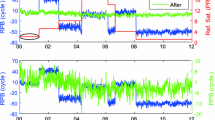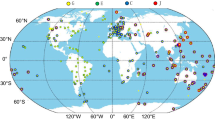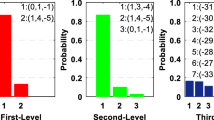Abstract
Phase fractional cycle biases (FCBs) originating from satellites and receivers destroy the integer nature of PPP carrier phase ambiguities. To achieve integer ambiguity resolution of PPP, FCBs of satellites are required. In former work, least squares methods are commonly adopted to isolate FCBs from a network of reference stations. However, it can be extremely time consuming concerning the large number of observations from hundreds of stations and thousands of epochs. In addition, iterations are required to deal with the one-cycle inconsistency among FCB measurements. We propose to estimate the FCB based on a Kalman filter. The large number of observations are handled epoch by epoch, which significantly reduces the dimension of the involved matrix and accelerates the computation. In addition, it is also suitable for real-time applications. As for the one-cycle inconsistency, a pre-elimination method is developed to avoid iterations and posterior adjustments. A globally distributed network consisting of about 200 IGS stations is selected to determine the GPS satellite FCBs. Observations recorded from DoY 52 to 61 in 2016 are processed to verify the proposed approach. The RMS of wide lane (WL) posterior residuals is 0.09 cycles while that of the narrow lane (NL) is about 0.05 cycles, which indicates a good internal accuracy. The estimated WL FCBs also have a good consistency with existing WL FCB products (e.g., CNES-GRG, WHU-SGG). The RMS of differences with respect to GRG and SGG products are 0.03 and 0.05 cycles. For satellite NL FCB estimates, 97.9% of the differences with respect to SGG products are within ± 0.1 cycles. The RMS of the difference is 0.05 cycles. These results prove the efficiency of the proposed approach.













Similar content being viewed by others
References
Collins P, Lahaye F, Héroux P, Bisnath S (2008) Precise point positioning with ambiguity resolution using the decoupled clock model. In: Proceedings of ION GNSS 2008, Institute of Navigation, Savannah, 16–19 Sept 2008, pp 1315–1322
Gabor MJ, Nerem RS (1999) GPS carrier phase AR using satellite-satellite single difference. In: Proceedings of ION GPS 1999, 14–17 Sept 1999, pp 1569–1578
Ge M, Gendt G, Rothacher M, Shi C, Liu J (2008) Resolution of GPS carrier-phase ambiguities in precise point positioning (PPP) with daily observations. J Geodesy 82(7):389–399
Geng J, Shi C (2016) Rapid initialization of real-time PPP by resolving undifferenced GPS and GLONASS ambiguities simultaneously. J Geodesy 91(4):361–374
Geng J, Meng X, Dodson AH, Teferle FN (2010) Integer ambiguity resolution in precise point positioning: method comparison. J Geodesy 84(9):569–581
Gu S, Lou Y, Shi C, Liu J (2015a) BeiDou phase bias estimation and its application in precise point positioning with triple-frequency observable. J Geodesy 89(10):979–979
Gu S, Shi C, Lou Y, Liu J (2015b) Ionospheric effects in uncalibrated phase delay estimation and ambiguity-fixed PPP based on raw observable model. J Geodesy 89(5):447–457
Hatch R (1982) The synergism of GPS code and carrier measurements. In: Proceedings of the third international symposium on satellite Doppler positioning at Physical Sciences Laboratory of New Mexico State University, 8–12 Feb 1982, pp 1213–1231
Kalman RE (1960) A new approach to linear filtering and prediction problems. J Basic Eng 82(1):35–45
Kouba J (2009) A guide to using International GNSS Service (IGS) products. International GNSS
Laurichesse D, Mercier F, Berthias J-P, Broca P, Cerri L (2009) Integer ambiguity resolution on undifferenced GPS phase measurements and its application to PPP and satellite precise orbit determination. Navigation 56(2):135–149
Li X, Zhang X (2012) Improving the estimation of uncalibrated fractional phase offsets for PPP ambiguity resolution. J Navig 65(3):513–529
Li X, Ge M, Zhang H, Wickert J (2013) A method for improving uncalibrated phase delay estimation and ambiguity-fixing in real-time precise point positioning. J Geodesy 87(5):405–416
Li P, Zhang X, Ren X, Zuo X, Pan Y (2015) Generating GPS satellite fractional cycle bias for ambiguity-fixed precise point positioning. GPS Solut 20(4):771–782
Li P, Zhang X, Guo F (2017) Ambiguity resolved precise point positioning with GPS and BeiDou. J Geodesy 91(1):25–40
Lou Y, Zheng F, Gu S, Wang C, Guo H, Feng Y (2016) Multi-GNSS precise point positioning with raw single-frequency and dual-frequency measurement models. GPS Solut 20(4):849–862
Loyer S, Perosanz F, Mercier F, Capdeville H, Marty J-C (2012) Zero-difference GPS ambiguity resolution at CNES-CLS IGS Analysis Center. J Geodesy 86(11):991–1003
Melbourne WG (1985) The case for ranging in GPS-based geodetic systems. In: Proceedings of the first international symposium on precise positioning with the Global Positioning System, Rockville, pp 373–386
Shi J, Gao Y (2014) A comparison of three PPP integer ambiguity resolution methods. GPS Solut 18(4):519–528
Tegedor J, Liu X, Jong K, Goode M, Øvstedal O, Vigen E (2016) Estimation of Galileo uncalibrated hardware delays for ambiguity-fixed precise point positioning. Navigation 63(2):173–179
Teunissen PJG, Khodabandeh A (2015) Review and principles of PPP-RTK methods. J Geodesy 89(3):217–240
Wang M, Chai H, Li Y (2017) Performance analysis of BDS/GPS precise point positioning with undifferenced ambiguity resolution. Adv Space Res 60(12):2581–2595. https://doi.org/10.1016/j.asr.2017.01.045
Wübbena G (1985) Software developments for geodetic positioning with GPS using TI-4100 code and carrier measurements. In: Proceedings of the first international symposium on precise positioning with the global positioning system, Rockville, pp 403–412
Yang Y (2006) Adaptive navigation and kinematic positioning. Surveying and Mapping Press, Beijing
Yang Y, Gao W, Zhang X (2010) Robust Kalman filtering with constraints: a case study for integrated navigation. J Geodesy 84(6):373–381
Zhang X, Li P (2013) Assessment of correct fixing rate for precise point positioning ambiguity resolution on a global scale. J Geodesy 87(6):579–589
Acknowledgements
We thank the IGS, GFZ and CNES for providing GNSS data and products. Thanks also goes to Prof. ZHANG Xiaohong and Dr. LI Pan from WHU-SGG for FCB products and valuable discussions. Guorui XIAO is supported by the China Scholarship Council. This work was supported in part by the National Natural Science Foundation of China (Grant Nos. 41674016 and 41274016).
Author information
Authors and Affiliations
Corresponding author
Rights and permissions
About this article
Cite this article
Xiao, G., Sui, L., Heck, B. et al. Estimating satellite phase fractional cycle biases based on Kalman filter. GPS Solut 22, 82 (2018). https://doi.org/10.1007/s10291-018-0749-3
Received:
Accepted:
Published:
DOI: https://doi.org/10.1007/s10291-018-0749-3




